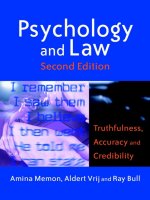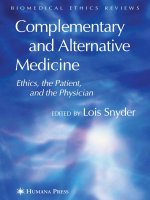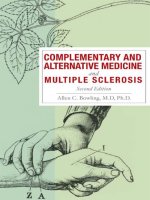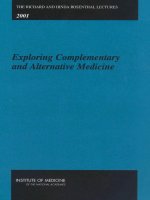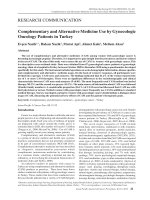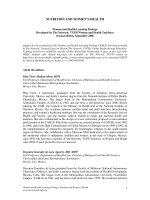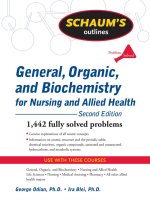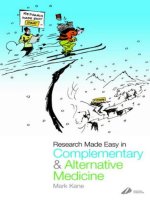Complementary and Alternative Medicine Second edition pptx
Bạn đang xem bản rút gọn của tài liệu. Xem và tải ngay bản đầy đủ của tài liệu tại đây (2.44 MB, 634 trang )
Complementary and Alternative
MedicineComplementary and
Alternative Medicine
Second edition
Edited by
Steven B Kayne
PhD, MBA, LLM, MSc(SpMed), DAgVetPharm, FRPharmS, FCPP,
FIPharmM, FFHom, MPS(NZ), FNZCP
Honorary Consultant Pharmacist, Glasgow Homeopathic Hospital, UK
Honorary Lecturer, University of Strathclyde School of Pharmacy, UK
London
и
Chicago
Published by the Pharmaceutical Press
An imprint of RPS Publishing
1 Lambeth High Street, London SE1 7JN, UK
100 South Atkinson Road, Suite 200, Grayslake, IL 60030-7820, USA
© Pharmaceutical Press 2009
is a trade mark of RPS Publishing
RPS Publishing is the publishing organisation of the
Royal Pharmaceutical Society of Great Britain
First edition published in 2001
Second edition published in 2009
Typeset by J&L Composition, Filey, North Yorkshire
Printed in Great Britain by TJ International, Padstow, Cornwall
ISBN 978 0 85369 763 3
All rights reserved. No part of this publication may be reproduced,
stored in a retrieval system, or transmitted in any form or by any
means, without the prior written permission of the copyright holder.
The publisher makes no representation, express or implied, with
regard to the accuracy of the information contained in this book and
cannot accept any legal responsibility or liability for any errors or
omissions that may be made.
The right of Steven B Kayne to be identified as the editor of this
work has been asserted by him in accordance with the Copyright,
Designs and Patents Act, 1988.
A catalogue record for this book is available from the British Library.
v
Contents
Preface vii
About the editor ix
Contributors x
Abbreviations xii
Part 1 Introduction to complementary and
alternative medicine 1
1 Introduction to the complementary concept of healthcare 3
2 Integrative medicine – incorporating complementary and
alternative medicine into practice 23
3 Delivering complementary and alternative medicine 43
4 Complementary and alternative medicine in the USA 93
5 The evidence base for complementary and alternative
medicine 121
6 Pharmacovigilance of complementary medicines 145
Part 2 Therapies involving use of medicines 185
7 Homeopathy and anthroposophy 187
8 Medical herbalism 269
9 Aromatherapy 341
10 Flower remedy therapy 383
Part 3 Traditional medicine 393
11 The traditional healthcare environment 395
12 Traditional Chinese medicine 415
13 Indian ayurvedic medicine 449
Part 4 Other therapies and diagnostic techniques 473
14 Naturopathy and its associated therapies 475
vi Contents
15 Diagnostic therapies 511
16 Manual therapies 517
17
Mind and body therapies 561
Index
597
vii
Preface
Much has happened since the first edition of this book appeared in 2002.
Despite the continuing paucity of robust scientific evidence to support
most of its constituent therapies, complementary and alternative medicine
(CAM) remains popular with clients who appreciate the holistic approach
and have a belief in its effectiveness. Some elements of CAM such as
aromatherapy and herbalism have acquired a more dedicated following,
whereas others including homeopathy have been subjected to a campaign
of scepticism in the UK in recent years, resulting in a reduction in the
services available under the country’s National Health Service. Interest in
traditional medicine, in particular Chinese and Indian medicine has
increased both by the arrival of immigrants, making it important for
health providers to have some knowledge of the principles and treatments
involved, and by host communities, resulting in the opening of Chinese
herbal medicine shops on the high streets of British cities.
Among healthcare providers there is an increasing realisation that
CAM is here to stay and must at least be acknowledged as a credible
option in appropriate circumstances. The concept of integrative medi-
cine is gaining ground. As statutory control of practitioners in many CAM
therapies and licensing of medicines becomes established full recognition
must surely follow.
This second edition has been reorganised and expanded with three
important new chapters covering integrative medicine, pharmacovigilance
and the marketing of CAM products in the USA. I am grateful to three
highly experienced colleagues from New Zealand and the USA for agree-
ing to contribute to these chapters, thus strengthening the content. The
book also provides an introduction to a much wider range of CAM
therapies. It is divided into four parts:
1. The first part serves as an introduction and deals with the
concepts that underpin CAM practice
2. The second part looks at therapies that generally, but not ex-
clusively, involve the use of medicines after a consultation or
through self-treatment
viii Preface
3. The third part gives information on traditional medicine
4. The fourth part covers a range of other therapies and diagnostic
procedures.
An abbreviated FASTtrack version of this book, covering the major top-
ics and providing self-assessment exercises, was also published by the
Pharmaceutical Press in 2008. It has been designed as a resource to as-
sist students preparing for examinations
Steven B Kayne
Glasgow, August 2008
ix
About the editor
Dr Steven B Kayne practised as a Community Pharmacist in Glasgow for
more than 30 years before retiring from active practice in 1999. He is
currently Honorary Consultant Pharmacist at Glasgow Homeopathic
Hospital and Honorary Lecturer in CAM at the University of Strathclyde
School of Pharmacy. Steven was a member of the UK Advisory Board on
the Registration of Homeopathic Products from its formation in 1994
until he retired in 2008, and currently serves on two other UK
Government Expert Advisory Bodies: the Herbal Medicines Advisory
Committee and the Veterinary Products Committee. He has also acted as
an adviser to the WHO Collaborating Centre for Traditional Medicine
and chaired the European Committee on Homeopathy Pharmacy sub-
committee. Steven’s current interests are in patient communication and
the application of CAM in sports care and veterinary medicine
He has written numerous papers and journal articles and has pre-
sented as an invited speaker at conferences around the world on a vari-
ety of topics associated with complementary and alternative medicine.
Steven is a member of the editorial advisory board of several journals
and has authored, edited and contributed chapters to many books.
x
Contributors
Joanne Barnes, BPharm, PhD, MRPharmS, MPS (NZ)
Joanne Barnes is Associate Professor in Herbal Medicines at the School
of Pharmacy, Faculty of Medical and Health Sciences, University of
Auckland, New Zealand (since November 2005). Previously, she was
Lecturer in Phytopharmacy (2002–5) and Research Fellow (1999–2002)
in the Centre for Pharmacognosy and Phytotherapy, School of Pharmacy,
University of London, UK, and Research Fellow in Complementary
Medicines, Department of Complementary Medicine, University of
Exeter, UK (1996–99).
Joanne’s research explores the utilisation, safety and efficacy of
herbal medicines. In particular, this has focused on examining issues rel-
evant to the pharmacovigilance of herbal medicines, e.g. investigating
methods for the safety monitoring of herbal medicines and communica-
tion of information on herbal safety concerns. Joanne is a member of the
editorial boards of the journals Drug Safety, Phytotherapy Research,
International Journal of Pharmacy Practice and Current Clinical
Pharmacology, and is immediate past co-editor of Complementary
Therapies in Medicine and was editor (1996–99) and one of the founders
of FACT (Focus on Alternative and Complementary Therapies). She is
lead co-author of the reference text Herbal Medicines (third edition pub-
lished 2007), published by the Pharmaceutical Press, UK, and a co-author
of the reference text Fundamentals of Pharmacognosy and Phytotherapy
(Churchill Livingsone, 2004). Joanne is an honorary consultant to the
World Health Organization’s Collaborating Centre for International Drug
Monitoring, a member of Health Canada’s Natural Health Products
Directorate’s Expert Resource Group and, until moving to New Zealand,
was a member of the UK Medicines and Healthcare products Regulatory
Agency’s Independent Review Panel on Classification of Borderline
Products (1999–2005). Joanne is an elected member of the executive
committee of the International Society of Pharmacovigilance (2006 to
present) and was appointed as a Fellow of the Linnean Society of London
in 2003.
Iris R Bell, MD, PhD
Iris Bell is Professor of Family and Community Medicine, Psychiatry,
Psychology, Medicine, and Public Health at the University of Arizona
College of Medicine. Dr Bell received her AB degree from Harvard
University, magna cum laude in biology, PhD in Neuro- and
Biobehavioral Sciences, and MD from Stanford University. After psy-
chiatry residency at the University of California – San Francisco, she
served as a faculty member at the University of California – San
Francisco and, later, Harvard Medical School. She is Board certified in
Psychiatry, with added qualification in Geriatric Psychiatry. She is also
certified in biofeedback (Biofeedback Certification Institute of America)
and a fellow of the American College of Nutrition. Dr Bell has pub-
lished over 100 peer-reviewed articles, a dozen book chapters and a
monograph on environmental chemical sensitivity. She has received grant
funding from the National Institutes of Health, Department of Veterans
Affairs, and numerous private foundations to study topics including
biofeedback and psychophysiology, nutrition in dementia and depres-
sion, the neurobiology of environmental illness, and individual difference
predictors of classic homeopathy outcomes. Her current research
interests focus on synthesising complexity science and homeopathic
theory in understanding the healing process at the whole person level of
organisation.
JP Borneman, BS, MS, MBA, PhD
JP Borneman is the chairman and chief executive officer of Standard
Homeopathic Company and Hyland’s Inc. He holds master’s degrees in
chemistry in business from St Joseph’s University, Philadelphia, and a
Doctorate in health policy at University of Sciences in Philadelphia, with
a research interest in patient perceptions and patterns of use of comple-
mentary and alternative medicine (CAM). He serves as emeritus director
of the National Center for Homeopathy, director of the Consumer
Healthcare Products Association (CHPA), as well as a director, editor
and chairman of the Council on Pharmacy for the Homeopathic
Pharmacopoeia of the USA. He is also chairman of the regulatory affairs
committee for the American Association of Homeopathic Pharmacists, the
industry trade association, and serves on the advisory board of the St
Joseph’s University College of Arts and Sciences and as an adviser to the
board of the National Association of Chain Drug Stores.
Contributors xi
Abbreviations
95%CI 95% confidence interval
AAPS Arable Area Payments Scheme
ADHD attention deficit hyperactivity disorder
ADROIT Adverse Drug Reaction On-line Information
Tracking
ADR adverse drug reaction
AIDS acquired immune deficiency syndrome
AOR adjusted odds ratio
ANZTPA Australia New Zealand Therapeutic Products
Authority
ARGCM Australian Regulatory Guidelines for
Complementary Medicines
ATC anatomical–therapeutic–chemical
ATCM Association of Traditional Chinese Medicine
AVM-GSL Authorised Veterinary Medicine – General Sales List
BAHM British Association of Homeopathic Manufacturers
BHomP British Homeopathic Pharmacopoeia
BHMA British Herbal Medicine Association
CAM complementary and alternative medicine
CFCs chlorofluorocarbons
CFR Code of Federal Regulation
cGMP current good manufacturing practice
CHM Chinese herbal medicine
CHM Commission on Human Medicine
CHPA Consumer Healthcare Products Associations
CONSORT Consolidated Standards of Reporting Trials
CPPE Centre for Pharmacy Postgraduate Education
CRISP Computer Retrieval of Information on Scientific
Projects
CSM Committee on Safety of Medicines (since 2005
CHM)
DHA docosahexaenoic acid
DSHEA Dietary Supplement Health and Education Act
xii
EBM evidence-based medicine
EFA essential fatty acid
ESCOP European Scientific Cooperative on Phytotherapy
EU THMPD European Union Traditional Herbal Medicinal
Products Directive
FAO Food and Agriculture Organization
FDA US Food and Drug Administration
FDCA Food, Drug and Cosmetic Act
FM Feldenkreis method
FTC Federal Trade Commission
GGHOS Glasgow Homeopathic Hospital Outcome Scale
GHP German Homeopathic Pharmacopoeia
GMP good manufacturing practice
HA health authority
HBM Health Belief Model
HIV human immunodeficiency virus
HMP herbal medicinal product
HMPWG Heads of European Medicines Agencies
Homeopathic Medicinal Product Working Group
HRQoL health-related quality of life
HPCUS Homeopathic Pharmacopeia Convention for the
United States
HPUS Homeopathic Pharmacopeia of the United States
HUFA highly unsaturated fatty acid
IM integrative medicine
IOM Institute of Medicine
LOC locus of control
MA marketing authorisation
MAOI monoamine oxidase inhibitor
MHLC Multidimensional Health Locus of Control
MHRA Medical and Healthcare products Regulatory
Agency
MRSA meticillin-resistant Staphylococcus aureus
NAHAT National Association of Health Authority and Trusts
NCCAM National Center for Complementary and Alternative
Medicine
NCRs non-conventional remedies
NDA new drug application
NES NHS Education for Scotland
NHIS National Health Information Survey
NHP Nottingham Health Profile or natural health product
Abbreviations xiii
NHS National Health Service
NIH National Institutes of Health
NIMH National Institute of Medical Herbalists
NMQP non-medically qualified practitioner
NSAID non-steroidal anti-inflammatory drug
NVNM non-vitamin, non-mineral
NZFSA New Zealand Food Safety Authority
OAM Office of Alternative Medicine
OM orthodox medicine
OR odds ratio
OTC over the counter
PEM prescription event monitoring
PHLC powerful others health locus of control
QALY quality-adjusted life-years
QoL quality of life
RCHM Register of Chinese Herbal Medicine
RCT randomised controlled trial
RMT rhythmical massage therapy
RPSGB Royal Pharmaceutical Society of Great Britain
RR response rate
SSRI selective serotonin reuptake inhibitor
TCM traditional Chinese medicine
TDS total dissolved solid
TGA Therapeutic Goods Administration
TM traditional medicine
UMC Uppsala Monitoring Centre
VMD Veterinary Medicines Directorate
WHO World Health Organization
WWF Worldwide Fund for Nature or World Wildlife Fund
(US & Canada)
xiv Abbreviations
Part 1
Introduction to complementary
and alternative medicine
Introduction to the complementary
concept of healthcare
Steven B Kayne
Definitions
Trying to construct a definition that covers a large heterogeneous group
of complementary and alternative therapies is difficult. Many therapies
are well known whereas others may be exotic, mysterious or even dan-
gerous. Some relaxation techniques, massage therapies, special diets and
self-help groups could be considered to be lifestyle choices rather than
true therapeutic interventions, although it could be argued that an
enhanced feeling of well-being is sufficient to warrant the inclusion of a
procedure in the latter.
Support for the complementary notion of healthcare is far from
universal. Saks rejects the term complementary and alternative
medicine (CAM) because, in his view, it ‘excludes therapies such as
homoeopathy which in their purest form are based on philosophies that
fundamentally conflict with medical orthodoxy’.
1
He opts for the term
‘alternative medicine’ and defines it thus:
Alternative Medicine can be taken to encompass all the health care prac-
tices that at any specific point in time generally do not receive support
from the medical establishment in the British context, whether this be
through such mechanisms as orthodox medical research funding, sympa-
thetic coverage in the mainstream medical journals or routine inclusion in
the mainstream medical curriculum. (page 4)
The term ‘alternative’ is used widely in the USA, the point being
made that not all alternative therapies complement allopathic
medicine.
2
The opposite approach has been expressed by a paper in
which the authors’ aim was to determine the association between the
use of non-conventional and conventional therapies in a representative
population survey.
3
A total of 16 068 people aged 18 years or older
were involved in the study. Participants were asked about their visits to
non-conventional and conventional practitioners during the past year.
From the resulting data it was estimated that:
• 6.5% of the US population had visited both types of practitioner
during the year studied
• 1.8% visited only non-conventional practitioners
• 59.5% visited only conventional practitioners
• 32.2% visited neither type of practitioner.
It appeared, therefore, that unconventional therapies were being
used to complement orthodox treatments rather than to replace them.
In fact, CAM is often used alongside orthodox medicine (OM) to
treat different aspects of a disease. Rarely are the two therapies used
to treat exactly the same symptoms. In fact evidence suggests that
many Americans use CAM in addition, rather than as an alternative
to, OM.
4
The following definition has been suggested by colleagues working
at Harvard Medical School:
5
Alternative medicine refers to those practices explicitly used for the pur-
pose of medical intervention, health promotion or disease prevention
which are not routinely taught at US Medical Schools nor routinely
underwritten by third-party payers within the existing US health care
system. (page 5)
Lannoye has suggested that it may be misleading to make a firm distinc-
tion between the terms ‘complementary’ and ‘alternative’, because it is
the precise context within which a therapy is being used that will
determine just how it should be defined at any one time.
6
Not all proponents of complementary medicine agree with the
terms ‘complementary’ and ‘alternative’. They believe that the use of
such terminology serves to emphasise the gap between the OM and
CAM approaches. They would prefer to see the various CAM therapies
referred to as specialities within an integrated medical system of
practice (see Chapter 2) and not grouped together under a separate label.
Complementary and alternative medicine is frequently described by
what it is not, rather than what it is. Thus, it may be described as being
‘not taught formally to health professionals’ or ‘not having a robust evi-
dence base’. Current definitions often obscure the debate about holism
and integrative care and give therapies and therapists precedence over
patients in the design of healthcare systems, for example:
7
CAM is a group of non-orthodox and traditional therapies that may be
used alone, or to complement orthodox or other non orthodox therapies,
4 Complementary and Alternative Medicine
in the treatment and prevention of disease in human and veterinary
patients. (pages 413–16)
The term ‘traditional therapy’ is defined in Chapter 11. Ernst et al
have proposed the following definition:
8
Complementary medicine is a diagnosis, treatment and/or prevention
which complements mainstream medicine by contributing to a common
whole, by satisfying a demand not met by orthodoxy or by diversifying
the conceptual framework of medicine.
This definition poses at least two questions:
1. What is meant by ‘mainstream’?
2. Whom does complementary medicine seek to satisfy?
A rather more comprehensive definition by the Cochrane Collaboration
was reported by Zollman and Vickers in 2000.
9
The Cochrane
Collaboration is an international organisation that aims to help people
make well informed decisions about healthcare by preparing, maintain-
ing and promoting the accessibility of systematic reviews of the effects
of healthcare interventions. The main output of the Collaboration is
through the Cochrane Library an electronic database that is updated
quarterly and distributed on CD-Rom and via the Internet.
The Cochrane definition is as follows:
CAM is a broad domain of healing resources that encompasses all health
systems, modalities and practices and their accompanying theories and
beliefs, other than those intrinsic to the politically dominant health systems
of a particular society or culture in a given historical period.
CAM includes all such practices and ideas self-defined by their users
as preventing or treating illnesses or promoting health and well-being.
Boundaries within CAM and between the CAM domain and that of the
dominant system are not always sharp or fixed.
The definition of CAM differs slightly from country to country. For
example, in Japan, Japanese herbal medicine (part of Kampo medicine)
and acupuncture are covered by public health insurance, so Japanese
practitioners of Kampo and acupuncture would object to their inclusion
in CAM and would rather regard themselves as belonging to the authen-
tic traditional medicine. However, these treatments are categorised as
CAM in Europe and the USA.
The following definition is preferred by the author because it
implies a greater degree of flexibility:
CAM is a group of non-orthodox and traditional therapies that may be
used alone, or to complement orthodox or other non-orthodox therapies,
Introduction to the complementary concept of healthcare 5
in the treatment and prevention of disease in human and veterinary
patients.
It would be appropriate to offer two further definitions at this stage.
Patients: by convention anyone who is unwell is usually called a patient
derived from the Latin patior – ‘to suffer’. Throughout this book this
generic term will be used to identify people who are unwell, whether
they are to be treated by orthodox or complementary medicine. This is
not meant to imply that other words such as ‘client’ or ‘customer’ are
inappropriate in certain circumstances, merely that one word is being
used to prevent confusion.
Disease is used in its orthodox sense to mean the following related items,
collectively recognised as having a separate coexistence and origin:
• A group of subjective problems reported by the patient (symptoms)
• Objective alterations in body functions, usually identified by a
trained observer (signs)
• The results of various investigations or procedures (investigations).
It has been pointed out that disease and health are commonly thought
of as distinct opposites.
10
In fact, both may be considered to be facets
of healthy functioning, each necessary for the other and each giving rise
to the other. Thus, disease may be thought of as a manifestation of
health – it is the healthy response of an individual striving to maintain
equilibrium within his or her body. Disease can be viewed as a mean-
ingful state that can inform health professionals how to help patients
heal themselves. People’s problems then become ‘diseases of meaning’.
The art and science of medicine
Throughout history there have been two separate traditions in the prac-
tice of medicine. One is the so-called ‘art of healing’ and usually
involves its own specialised brand of training and relies mainly on a pre-
scriber’s intuition and patient perceptions of successful outcomes. The
tradition should not be confused with the art of healing programme, an
initiative that aims to use the arts as a form of therapy to soothe
patients’ minds and bodies and help them on their path to recovery
11
(see Chapter 18). The second tradition, the ‘science of healing’, is based
on technological and scientific ideas and leaves much less opportunity
for practitioners to express an innovative and intuitive approach to
medicine.
6 Complementary and Alternative Medicine
In the past, the phrase ‘art of medicine’ was often applied to the
practice of CAM. Practitioners have used the phrase to cover up a good
deal of muddled thinking and uncritically accepted prejudices. The term
is perhaps most misleading when applied to aspects of medical practice
that are amenable to empirical study but about which sufficient data
have not been accumulated. Practitioners commonly used the word
‘philosophy’ in a similar context, e.g. ‘My philosophy for using antihis-
tamines to treat allergies is . . .’. Implicit in such usage is the erroneous
assumption that what has been labelled a matter of philosophy or per-
sonal opinion is thereby exempt from rigorous evaluation. This view
has hampered the progress of CAM. However, the situation is being
forced to change with the growing importance of evidence-based
medicine to purchasers, providers and patients alike.
There has not always been a clear and strict division between art and
science.
12
The purpose of anatomical images from the Renaissance until
the nineteenth century had as much to do with aesthetics and disclosing
the ‘divine architecture’ as with the intention of medical illustration.
Medical science was more closely linked with a ‘naturalistic observation’
than with ‘intervention’, and this was the dominant view until well into
the nineteenth century. Since then scientific medicine and non-scientific
medicine have interacted. In some cases this interaction has had pos-
itive results, with one supplying features that the other has lacked, e.g.
homeopathic remedies may be used alongside orthodox medicines to
treat different aspects of the same disease. Complementary therapies
usually stress the idea of restoring a patient’s overall wellness rather
than merely seeking a reduction in any particular clinical symptom.
Unfortunately, there has been considerable suspicion, and scepti-
cism, voiced by members of the scientific and medical community when
referring to CAM. Orthodox medicine insists that the evidence support-
ing CAM is flimsy or absent.
13,14
Some treatments are not supported by
any randomised clinical trials at all. In other cases there are trials that
are methodologically flawed with inappropriate conclusions. Sceptics
go on to claim that the inability to explain mechanisms of action of
most complementary disciplines equates to a simple placebo response at
best, and quackery at worst. CAM proponents point out that many
orthodox interventions are not proven to be effective beyond reason-
able doubt nor can their mechanisms be adequately explained, yet they
still remain in routine use. Further a placebo effect is evident in ortho-
dox medicine. A study testing pain relief from analgesics showed that
merely telling people that a novel form of codeine that they were taking
(actually a placebo) was worth $US2.50 (£1.25 or €1.58) rather than
Introduction to the complementary concept of healthcare 7
10 cents increased the proportion of people who reported pain relief
from 61% to 85.4%.
15
When the ‘price’ of the placebo was reduced, so
was the pain relief.
Modern scientific thinking believes that knowledge should be
pursued by the following criteria:
16
• Objectivism: the observer is separate from the observed
• Reductionism: complex phenomena are explainable in terms of
simpler component phenomena
• Positivism: all information can be derived from physically
measurable data
• Determinism: phenomena can be predicted from scientific laws
and environmental conditions.
Complementary medicine just does not fit into this mould. Most
complementary disciplines have developed from patient-oriented stud-
ies – observational and anecdotal information assembled over hundreds
and, in some cases, even thousands of years. This does not answer the
very real criticisms about lack of detailed evidence of effectiveness or
concerns over possible dangers.
Complementary and alternative approaches to healthcare
Complementary and alternative medicine is a term applied to over 700
different treatments and some diagnostic methods. A distinction is
sometimes made between CAM (involving the use of medicines or other
products) and complementary and alternative therapies (including inter-
ventions that rely on procedures alone). In this book the term ‘comple-
mentary and alternative medicine’ (CAM) is used to describe all types
of non-orthodox medicine.
The words complementary and alternative are often used inter-
changeably. In the UK, health professionals prefer to use the former
because it implies an ability to complement or complete other treat-
ments. There is evidence to show that this is what happens in practice.
Users of CAM are not so much seeking alternatives as a result of direct
dissatisfaction, but are more probably using complementary therapies
in parallel,
17
except in the case of purchasing homeopathic medicines
over the counter in a pharmacy.
18
Alternative, on the other hand,
implies ‘instead of’ or a choice between two courses of action, e.g.
whether to treat a patient with orthodox (or ‘allopathic’) medicine or
with homeopathy. In fact there are many instances where patients can
benefit from using the best of both worlds. It is not unusual for homeo-
8 Complementary and Alternative Medicine
pathic doctors in the UK to prescribe an antibiotic and a homeopathic
medicine (e.g. Belladonna) on the same prescription form. In some cases
CAM practitioners may use more than one complementary discipline
concurrently. Asthma, for example, may be treated by a whole range of
therapies, including relaxation, breathing exercises, yoga, as well as
neutraceuticals, homeopathy and acupuncture.
19
It is significant that the 1986 BMA report was entitled ‘Alternative
medicine’,
20
whereas 6 years later in its next report it was using the title
‘Complementary medicine’. A similar trend in the literature can be
observed over the same period of time. In the early 1990s a British phar-
macy launched an involvement in what it initially called alternative
medicine, quickly changing its promotional material to use the term
‘complementary medicine’ within some months (see also Chapter 2).
Perceptions of the OM and CAM approaches to healing
The following terms have been applied to describe the OM and CAM
approaches to healing:
21
OM CAM
Orthodox Unorthodox, unconventional
Conventional Alternative
Established Fringe
Scientific Natural
Proven Unproven
All of these words communicate a particular viewpoint, some
betraying the preconceptions of people who apply them to the practice
of medicine.
The words ‘orthodox’ and ‘conventional’ clearly imply a certain
correctness in the approach to healing. ‘Established’ similarly suggests
that a degree of authority has been applied, perhaps by learned bodies
or even society as a whole. ‘Scientific’ and ‘proven’ imply an expected,
almost guaranteed, successful outcome.
By contrast, in the other column we find ‘unorthodox’ defined as
being irregular, unwanted or unusual. From a sociological viewpoint
unconventional therapy refers to medical practices that are not in confor-
mity with the accepted standards of the medical community and there-
fore not taught at medical schools. ‘Alternative’ is a neutral word
meaning presenting a choice. ‘Fringe’ and ‘unproven’ are words associ-
ated with a wish to marginalise the subject. Used in this context ‘natural’
could mean unstandardised.
Introduction to the complementary concept of healthcare 9
Over recent years OM has become better at curing and helping
with diseases but worse at relieving illness and sickness, and providing
comfort. One of the key roles of CAM is in the management of illness
and sickness and the provision of human comfort.
22
The healing response
What does healing mean? In the minds of many CAM practitioners heal-
ing means restoring an unwell patient to his or her own particular state
of wellness – not simply seeking to treat a condition in isolation. Does the
term mean actively treating, i.e. a meaningful intervention provided by a
practitioner during a consultation? Reilly
23
has suggested that the heal-
ing response begins long before the consultation and ends long after it
finishes. A potential for change is inherent – and a creative ‘meeting’ may
be the potent agent of its release – with or without prescriptions.
Self-healing
One aspect of healing that is common to all the therapies that collec-
tively make up CAM is the belief that they work by stimulating the
body to heal itself.
This response can be initiated by administering carefully chosen
interventions – medicines or a physical procedure by the practitioner
alone during a well-structured consultation. The quality of the consul-
tation can be an important element in initiating a positive response in
human patients
24
and perhaps in animals too. It is an interesting argu-
ment that, if this is indeed the case, i.e. if the interaction is so important,
then self-treating with CAM including the purchase of over-the-counter
(OTC) medicines without advice, might exclude a major source of the
healing process. Not being able to see the wood for the trees might be
the appropriate expression!
One could consider whether a definition of healing should include
a reference to a person’s intrinsic genetic or acquired ability to with-
stand disease itself, without external intervention. There are many
examples of the body’s ability to heal itself if given the chance.
Hippocrates was born on the Greek island of Kos, now a popular
holiday destination. During his lifetime it is said that people came to
him in their thousands to seek his advice for their ills. They found a
Temple of Healing dedicated to the god Asclepius. Inside the stone walls
of the Temple and beside bubbling mineral springs, the medical pilgrims
experienced a ritual relaxation programme called incubation or temple
10 Complementary and Alternative Medicine
